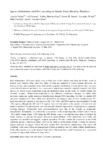Species delimitation and DNA barcoding of Atlantic Ensis (Bivalvia, Pharidae)

Use this link to cite
http://hdl.handle.net/2183/19231Collections
- Investigación (FCIE) [1229]
Metadata
Show full item recordTitle
Species delimitation and DNA barcoding of Atlantic Ensis (Bivalvia, Pharidae)Author(s)
Date
2013-09-03Citation
Vierna, J., Cuperus, J., Martínez-Lage, A., Jansen, J.M., Perina, A., Van Pelt, H. & González-Tizón, A.M. (2013). Species delimitation and DNA barcoding of Atlantic Ensis (Bivalvia, Pharidae). Zoologica Scripta, 43, 161–171.
Abstract
[Abstract] Ensis Schumacher, 1817 razor shells occur at both sides of the Atlantic and along the Pacific coasts of tropical west America, Peru, and Chile. Many of them are marketed in various regions. However, the absence of clear autapomorphies in the shell and the sympatric distributions of some species often prevent a correct identification of specimens. As a consequence, populations cannot be properly managed, and edible species are almost always mislabelled along the production chain. In this work, we studied whether the currently accepted Atlantic Ensis morphospecies are different evolutionary lineages, to clarify their taxonomic status and enable molecular identifications through DNA barcoding. For this, we studied 109 specimens sampled at 27 sites, which were identified as belonging to nine of those morphospecies. We analysed nucleotide variation at four nuclear (18S, 5.8S, ITS1, and ITS2) and two mitochondrial (COI and 16S) regions, although the 18S and 5.8S regions were not informative at the species level and were not further considered. The phylogenetic trees and networks obtained supported all morphospecies as separately evolving lineages. Phylogenetic trees recovered Ensis at each side of the Atlantic as reciprocally monophyletic. Remarkably, we confirm the co-occurrence of the morphologically similar E. minor (Chenu, 1843) and E. siliqua (Linné, 1758) along the NW Iberian coast, a fact that has been often overlooked. In South America, a relevant divergence between E. macha (Molina, 1792) individuals from Chile and Argentina was unveiled and suggests incipient speciation. We also confirm the occurrence of the North American species E. directus (Conrad, 1843) as far south as north-eastern Florida. Among the genomic regions analysed, we suggest COI as the most suitable DNA barcode for Atlantic Ensis. Our results will contribute to the conservation and management of Ensis populations and will enable reliable identifications of the edible species, even in the absence of the valves. The name Ensis coseli Vierna nom. nov. is proposed to replace E. minor Dall, 1899 non (Chenu, 1843).
Keywords
Razor clam
COI
16S rDNA
18S rDNA
Phylogeny
COI
16S rDNA
18S rDNA
Phylogeny
Editor version
Rights
This is the peer reviewed version of the following article: Vierna, J., Cuperus, J., Martínez-Lage, A., Jansen, J.M., Perina, A., Van Pelt, H. & González-Tizón, A.M. (2013). Species delimitation and DNA barcoding of Atlantic Ensis (Bivalvia, Pharidae). Zoologica Scripta, 43, 161–171, which has been published in final form at https://doi.org/10.1111/zsc.12038. This article may be used for non-commercial purposes in accordance with Wiley Terms and Conditions for Self-Archiving.
ISSN
0300-3256
1463-6409
1463-6409





